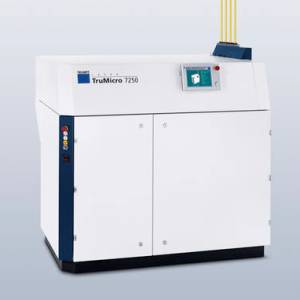Aug 3 2010
"The laser as an industrial tool is a key technology in the photovoltaics industry," said Jürgen Stollhof, Program Manager Micro Processing at TRUMPF Inc., Farmington, USA. In his presentation "New lasertechnology to enhance the performance of photovoltaic cells," which was delivered at the trade fair Intersolar North America, July 2010 in San Francisco, he stated that new laser technologies, such as ultra-short pulsed lasers, for example, make new production methods possible.
The maximum cell efficiency can be achieved only with extremely precise and fine surface structuring. "Here, the laser comes fully into its own and is significantly more efficient compared to alternative processes, because of increased output and lower production costs," Stollhof said.
Lasers for thin-film solar cell processing
In the production of solar modules from amorphous silicon (aSi) or cadmium telluride (CdTe), conductive and photoactive films are deposited on large substrate areas, such as glass. "After every deposition, the laser subdivides the surface in such a way that the cells created are automatically switched in series by the process sequence," Stollhof stated. In this way, cell and module tensions, depending on the cell width, can be set. The transparent conductive oxides (TCO) are usually processed with lasers of infrared wavelength. At typical feed rates, repetition rates of over 100 kilohertz result. An optimized pulse to pulse overlap makes for a clean kerf and minimizes negative heat effects. "Small, compact instruments such as lasers of the TRUMPF TruMicro Series 3000 with wavelengths of 1064 and 532 nanometers are ideal for P1, P2, and P3 patterning. Thanks to their high pulse-to-pulse stability, the diode-pumped solid-state lasers do not just achieve very good processing results, but they can also be easily integrated into existing systems because of their advanced cooling design.
 The TRUMPF TruMicro Series presents a range of microprocessing lasers customized for structuring, stripping and cutting applications in solar cell production.
The TRUMPF TruMicro Series presents a range of microprocessing lasers customized for structuring, stripping and cutting applications in solar cell production.
The patterning of thin-film cells made of Cu(In,Ga)(S,Se)2, also known as CI(G)S, presents a particularly high challenge for the laser process. This is true for structuring of molybdenum, too. For this application, nanosecond lasers are still used. But Stollhof emphasized that far better solutions exist in the market, such as picosecond lasers. "With these lasers, the material is ablated with ultrashort pulses without significant heating of the process edge zone, which will prevent cracking, melting or exfoliation of the layers," he explained.
TRUMPF offers powerful picosecond lasers of the TruMicro Series 5000 with a wavelength of 1030 nm for structuring of molybdenum and 515 nm for processing of photoactive material and the patterning of the front contact. In addition, TRUMPF's TruMicro Series 5000 are the picosecond lasers with up to 50 watts output power on the market, which show the best cost of operation per watt.
Edge deletion: Lasers replace sandblasting
To protect thin-film solar modules against unfavorable environmental influences, especially against moisture, a width of approximately 10 millimeters of the layer system is ablated along the edge and covered with a laminated film. For the most part, the photovoltaic industry still uses sandblasting for this purpose. "But using lasers is a far more suitable process," explained Stollhof.
The tool of choice for this application is the TruMicro 7050, which can process large areas at production speed reliably and securely. It generates pulses with a duration of 30 nanoseconds at an average power of 750 watts.
Crystalline solar cells: Lasers reduce the per watt costs
Future laser applications include the selective ablation of passivated layers on crystalline solar cells. Here, lasers with ultrashort pulses and high pulse energies are particularly well-suited, due to the excellent beam quality. Said Stollhof: "These conditions can be achieved only by means of laser disk technology at this time. "Because of the simple scalability of the laser output, a higher production capacity can be achieved, and the high beam quality in the ultrashort pulses significantly improves solar cell efficiency. In closing, Stollhof said: "All this will result in reducing the per watt costs of solar cell performance significantly in future."
Source: http://www.trumpf.com/